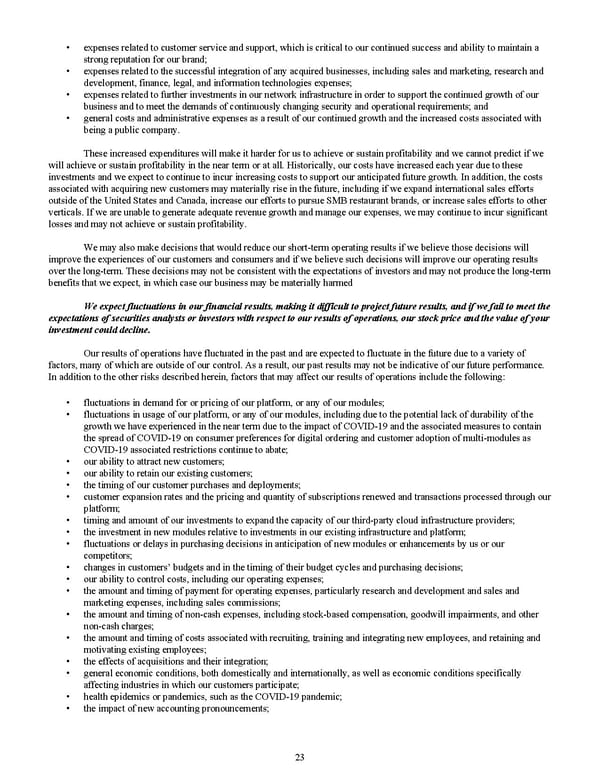• expenses related to customer service and support, which is critical to our continued success and ability to maintain a strong reputation for our brand; • expenses related to the successful integration of any acquired businesses, including sales and marketing, research and development, finance, legal, and information technologies expenses; • expenses related to further investments in our network infrastructure in order to support the continued growth of our business and to meet the demands of continuously changing security and operational requirements; and • general costs and administrative expenses as a result of our continued growth and the increased costs associated with being a public company. These increased expenditures will make it harder for us to achieve or sustain profitability and we cannot predict if we will achieve or sustain profitability in the near term or at all. Historically, our costs have increased each year due to these investments and we expect to continue to incur increasing costs to support our anticipated future growth. In addition, the costs associated with acquiring new customers may materially rise in the future, including if we expand international sales efforts outside of the United States and Canada, increase our efforts to pursue SMB restaurant brands, or increase sales efforts to other verticals. If we are unable to generate adequate revenue growth and manage our expenses, we may continue to incur significant losses and may not achieve or sustain profitability. We may also make decisions that would reduce our short-term operating results if we believe those decisions will improve the experiences of our customers and consumers and if we believe such decisions will improve our operating results over the long-term. These decisions may not be consistent with the expectations of investors and may not produce the long-term benefits that we expect, in which case our business may be materially harmed We expect fluctuations in our financial results, making it difficult to project future results, and if we fail to meet the expectations of securities analysts or investors with respect to our results of operations, our stock price and the value of your investment could decline. Our results of operations have fluctuated in the past and are expected to fluctuate in the future due to a variety of factors, many of which are outside of our control. As a result, our past results may not be indicative of our future performance. In addition to the other risks described herein, factors that may affect our results of operations include the following: • fluctuations in demand for or pricing of our platform, or any of our modules; • fluctuations in usage of our platform, or any of our modules, including due to the potential lack of durability of the growth we have experienced in the near term due to the impact of COVID-19 and the associated measures to contain the spread of COVID-19 on consumer preferences for digital ordering and customer adoption of multi-modules as COVID-19 associated restrictions continue to abate; • our ability to attract new customers; • our ability to retain our existing customers; • the timing of our customer purchases and deployments; • customer expansion rates and the pricing and quantity of subscriptions renewed and transactions processed through our platform; • timing and amount of our investments to expand the capacity of our third-party cloud infrastructure providers; • the investment in new modules relative to investments in our existing infrastructure and platform; • fluctuations or delays in purchasing decisions in anticipation of new modules or enhancements by us or our competitors; • changes in customers’ budgets and in the timing of their budget cycles and purchasing decisions; • our ability to control costs, including our operating expenses; • the amount and timing of payment for operating expenses, particularly research and development and sales and marketing expenses, including sales commissions; • the amount and timing of non-cash expenses, including stock-based compensation, goodwill impairments, and other non-cash charges; • the amount and timing of costs associated with recruiting, training and integrating new employees, and retaining and motivating existing employees; • the effects of acquisitions and their integration; • general economic conditions, both domestically and internationally, as well as economic conditions specifically affecting industries in which our customers participate; • health epidemics or pandemics, such as the COVID-19 pandemic; • the impact of new accounting pronouncements; 23
 2022 10K Page 29 Page 31
2022 10K Page 29 Page 31